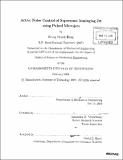| dc.contributor.advisor | Anuradha M. Annaswamy. | en_US |
| dc.contributor.author | Hong, Seung Hyuck | en_US |
| dc.contributor.other | Massachusetts Institute of Technology. Dept. of Mechanical Engineering. | en_US |
| dc.date.accessioned | 2009-08-26T17:09:42Z | |
| dc.date.available | 2009-08-26T17:09:42Z | |
| dc.date.copyright | 2009 | en_US |
| dc.date.issued | 2009 | en_US |
| dc.identifier.uri | http://hdl.handle.net/1721.1/46637 | |
| dc.description | Thesis (S.M.)--Massachusetts Institute of Technology, Dept. of Mechanical Engineering, 2009. | en_US |
| dc.description | Includes bibliographical references (leaves 111-113). | en_US |
| dc.description.abstract | This thesis concerns an active noise control of supersonic impinging jet flow using unsteady microjet injection. Supersonic impinging jet involves several problems such as lift loss, ground erosion, significant noise pollution, and sonic fatigue, all of which are dominated by impinging tones mainly caused by well-known phenomenon, the feed back loop. The main goal of this study is to achieve uniform and consistent noise reduction in the entire range of jet operating condition, by means of intercepting this feed back loop. Experimental investigations on ideally expanded Mach number 1.5, supersonic impinging jet flow were carried out at the scaled supersonic experimental facility. The actuator used for active control is composed of pulsed microjets, utilizing a fraction of mass flow rate needed with steady microjets. Two means of producing pulsed microjet were introduced; one with a rotating cap, pulsing at 16 - 100Hz, and the other developed based on the principle of Hartmann tube, pulsing at 4.4 - 6.1kHz, referred to as high frequency actuator. Control parameters related to pulsed microjet injection with rotating cap were varied to evaluate their effects on suppression of impinging tones, whereas the effect of high frequency actuator is shown only as an initial step and needs further investigation in the future. For pulsed microjet with rotating cap, mass flow rate, directly proportional to the supply pressure of microjet, is found to be the most important parameter amongst all and saturated supply pressures for steady and pulsed microjet are demonstrated. It is demonstrated that pulsed microjet gives more noise reduction than steady microjet with the same mass flow rate, at certain range of supply pressure, and also that pulsed microjet could be as effective on suppression of impinging tones as steady microjet with less mass flow rate. In addition, the effect of pulsed microjet on hot temperature impinging jet was examined since the jet is much hotter than ambient air in reality. The concept of extremum control strategy is introduced to more efficiently find an optimal pulsing condition for uniform and consistent noise reduction. | en_US |
| dc.description.statementofresponsibility | by Seung Hyuck Hong. | en_US |
| dc.format.extent | 113 leaves | en_US |
| dc.language.iso | eng | en_US |
| dc.publisher | Massachusetts Institute of Technology | en_US |
| dc.rights | M.I.T. theses are protected by
copyright. They may be viewed from this source for any purpose, but
reproduction or distribution in any format is prohibited without written
permission. See provided URL for inquiries about permission. | en_US |
| dc.rights.uri | http://dspace.mit.edu/handle/1721.1/7582 | en_US |
| dc.subject | Mechanical Engineering. | en_US |
| dc.title | Active noise control of supersonic impinging jet using pulsed microjets | en_US |
| dc.type | Thesis | en_US |
| dc.description.degree | S.M. | en_US |
| dc.contributor.department | Massachusetts Institute of Technology. Department of Mechanical Engineering | |
| dc.identifier.oclc | 426489319 | en_US |
